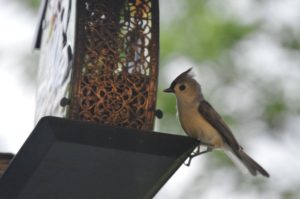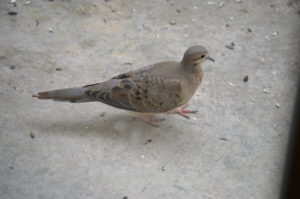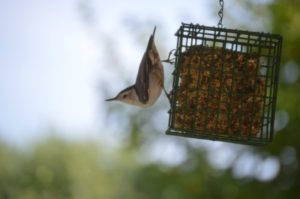By Angel Avery-Wright
One of my closest friends bought me a bird feeder for Christmas. I thought she was crazy. I do not watch birds, let alone feed them. It took me years to finally put it up. Something amazing happened. I discovered I have over 20 species of birds living in my neighborhood. I had no idea.
I now have 9 feeders between my porch and my back yard. I have three different species of woodpeckers visiting my feeders. I see cardinals and blue jays (easy to spot) but also grey catbirds, grosbeaks, chickadees, titmice and so many others. Some birds I see every day. Some I only see once a season. I had a hummingbird last year but only my husband got to see it.
I have seen baby woodpeckers being fed by their mother at my feeder. I have heard baby starlings yelling at their mom for more food. Nuthatches are the only bird that hang upside down when they eat. They are fascinating to watch.
Things to know and share:
- Not all birds migrate. Many of the birds local to the Lehigh Valley stay all year long. Titmice, chickadees, Juncos, Cardinals are just a few of the birds that stay. Robins, hummingbirds, and orioles migrate. Robins are one of the first signs of spring. And often people will say that the birds have returned. (Be careful, many birds never left).

- Where to start. Get a field guide that represents the birds in your area to use for identification. This way you will have an idea of what birds you may be able to attract. House finches and house sparrows are easy to find and look similar at first glance, but their markings are different.
- Where to see birds: Start with the backyard, playground, even city sidewalks, whatever is closest and available to observe birds.
- How to attract birds: Did you know that robins eat many other foods besides worms? Dried mealy worms are a good source of protein for birds in the winter. Different birds are attracted to different kinds of foods and some to different colors. Hibiscus plants are great for attracting hummingbirds and orange peels will attract orioles. Catbirds and woodpeckers love jelly. Sunflower seeds, peanuts, suet, and many other types of seeds will bring different birds.
- Keep in mind that if you put up a feeder, the type of feeder as well as what is in it, will determine which birds will visit. So, if you are looking to attract a specific bird, investigate what type of feeders first. Finches like small perches and cardinals prefer black sunflower seeds.
- Bird feeding is a commitment. Feeders need to be kept clean and filled. Birds will regularly return to feeders that are kept full. If it is empty too long, they will look elsewhere.
Activities:
- Clear plastic feeders that can be hung on the outside of windows will attract birds and make it very easy for children to observe.

- Scavenger hunts give children the opportunity to listen to bird sounds, look for birds, and look for signs of birds such as nests, eggs, feathers, etc. Birds can be found anywhere and everywhere. Large birds such as herons and egrets will be near small streams. Hawks, vultures, and other raptors can be seen flying. These birds like to fly when it’s warmest.
- Binoculars are a great way to search for and observe birds, but they are not easy for young children to use. I even found a wild turkey in my backyard and hawk hunting for small birds. You just never know what will show up.
Below are some additional resources for bird watching with children:
Easy Ways to Get Kids Birding
Birding with Children
Birdwatching With Children
Get to Know Birds




